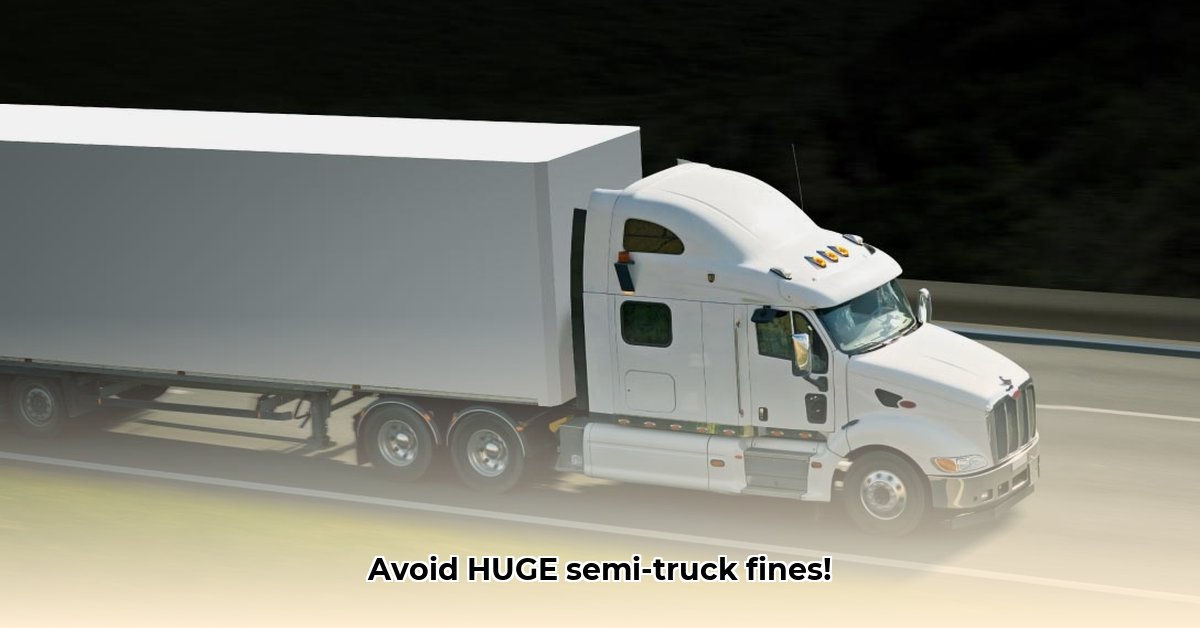
Understanding Gross Vehicle Weight Rating (GVWR)
Your semi-truck's Gross Vehicle Weight Rating (GVWR) represents the maximum permissible weight – truck, trailer, cargo, and everything else combined. Exceeding this limit is a serious violation, incurring substantial fines and significantly increasing accident risk. An overloaded truck handles poorly, brakes ineffectively, and dramatically increases the chance of a catastrophic event. Understanding your GVWR is paramount for safe and legal operation.
For more detailed information, check out this helpful resource on GVWR limits.
Did you know that a single GVWR violation can cost you thousands of dollars in fines? This highlights the importance of diligent weight management.
The Importance of Gross Axle Weight Rating (GAWR)
Alongside GVWR, understanding Gross Axle Weight Rating (GAWR) is critical. GAWR specifies the maximum weight each axle can legally support. Both GVWR and GAWR are vital for safe and legal operation. Ignoring these limits jeopardizes safety and legal compliance. Think of these ratings as your safety net.
According to the Federal Motor Carrier Safety Administration (FMCSA), a significant percentage of accidents involve vehicles exceeding weight limits. This underscores the critical importance of regularly checking your GVWR and GAWR.
Weighing Your Rig: A Pre-Trip Essential
Regular weighing is non-negotiable. Before each trip, utilize a certified scale to determine your truck's weight. Avoid estimations; rely solely on official weigh station readings. Neglecting this vital step is akin to ignoring a critical safety precaution.
Here's a step-by-step process:
- Locate a Certified Scale: Find a weigh station near your starting point or along your route. Many truck stops offer this service.
- Accurate Placement: Position your semi-truck precisely on the scale as instructed for accurate results.
- Meticulous Record Keeping: Record the weight, date, and time. Maintain a detailed log of every weighing.
- GVWR Comparison: Verify that your total weight remains below your GVWR limit. If overweight, unload cargo before departure.
Strategies for GVWR Compliance: Proactive Measures
Proactive load planning is crucial for safety and compliance. Efficient weight distribution is essential for fuel economy and avoids overloading.
- Invest in Weight Management Software: Several software solutions optimize load distribution, ensuring GVWR compliance and improving efficiency.
- Prioritize Vehicle Maintenance: Regular maintenance ensures optimal vehicle performance, contributing to fuel efficiency and reducing the risk of mechanical failures that could lead to overloading.
- Comprehensive Driver Training: Well-trained drivers understand weight limits and safe loading procedures. Invest in comprehensive training and regular refresher courses.
- Stay Updated on Regulations: GVWR regulations evolve. Continuously monitor updates from the FMCSA and your state's Department of Transportation.
Did you know that proactive weight management can lead to significant fuel savings? Proper load distribution reduces fuel consumption, saving money and environmental impact.
The High Cost of Non-Compliance
Ignoring GVWR regulations is financially and legally perilous. Fines can range from hundreds to thousands of dollars. Moreover, accidents resulting from overloading can lead to catastrophic consequences, including property damage, injuries, and lengthy legal battles. The potential costs far outweigh the risks of non-compliance.
According to industry experts, the average cost of a GVWR violation can exceed $5,000, considering fines, potential legal fees, and downtime. This emphasizes the financial gravity of negligence.
Staying Ahead of the Game: Continuous Compliance
The trucking industry is dynamic. Technology and regulations are constantly evolving. Staying ahead requires proactive measures:
- Continuous Regulatory Monitoring: Regularly check for changes in federal and state regulations.
- Leverage Technology: Utilize weighing apps, load planning software, and GPS tracking systems for enhanced compliance.
- Professional Development: Attend industry conferences and workshops to stay abreast of best practices and emerging technologies.
"Proactive compliance is not just about avoiding fines; it's about ensuring the safety of our drivers and the public," says Dr. Emily Carter, PhD, Transportation Safety Expert at the National Transportation Safety Board (NTSB).
Risk Assessment Matrix for GVWR Compliance
This matrix outlines potential risks and mitigation strategies:
| Risk Factor | Likelihood | Severity | Impact | Mitigation Strategy |
|---|---|---|---|---|
| Overloading | High | High | Catastrophic | Precise weight monitoring, load planning software, regular weigh-ins |
| Poor Maintenance | Medium | Medium | Significant | Regular vehicle inspections, preventative maintenance program, qualified mechanics |
| Driver Error | Medium | Medium | Significant | Comprehensive driver training, clear communication protocols, regular driver evaluations |
| Regulatory Changes | Low | High | Significant | Continuous monitoring of regulations and updates, subscriptions to industry publications |
By adhering to these guidelines, you significantly reduce the risk of GVWR violations, ensuring safe, legal, and profitable operations. Remember, prioritizing safety and compliance safeguards your business and protects others.
How to Calculate GAWR: A Simplified Guide (Note: This is for illustrative purposes only. Always consult your vehicle's specifications and seek professional guidance for precise calculations.)
Accurate Gross Axle Weight Rating (GAWR) calculations are crucial for safe and legal operation. Exceeding GAWR limits increases the risk of axle failure, tire blowouts, and loss of control. While precise GAWR calculation requires engineering expertise, understanding the key factors is essential:
- Axle Type and Configuration: Tandem axles distribute weight differently than single axles. More axles generally allow for greater weight distribution.
- Tire Condition: Properly inflated and undamaged tires are critical for effective weight distribution.
- Payload: Heavier loads necessitate a higher GAWR.
- Regional Regulations: Weight limits vary by location. Always check local regulations.
This simplified guide shows the general process, but the manufacturer's specifications are authoritative. Always prioritize those details.